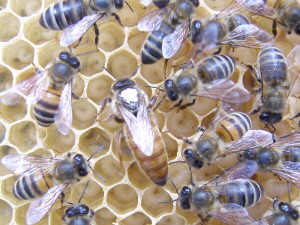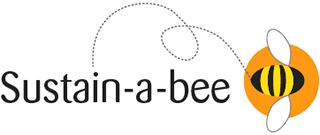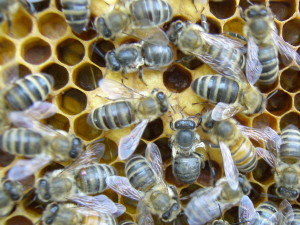 Honeybees have been studied by man for thousands of years…
Honeybees have been studied by man for thousands of years…
They are fascinating creatures who’s ability to communicate with each other with dances and waggles differs amongst species – suggesting they may have different language and dialects.
The Queen is the head of the colony – she is much larger than the other bees (see right: with white spot) and she is the one who lays the eggs within the colony. The Queen can lay worker eggs (females) and drone eggs (males).
The majority of bees in the colony are workers and the drones are raised in the active season. Each bee has a specific job within the hive and they are allocated tasks such as nursing new bees, tending the Queen, creating beeswax for comb production.
Bees fly around searching for food and they forage for nectar and pollen around the hive – they can travel for up to three miles and they navigate by the sun. Each 1lb of honey is estimated to need one bee to travel the equivalent distance of three times around the globe to produce – so a lot of effort goes into making every jar of honey.
Pollination is a result of bees visiting plants and flowers and is extremely valuable to man. The seeds produced from this enables us all to eat food and vegetables and without this there would be very little variety in our food at all.
The colony of bees goes through many changes throughout the year and no day is the same as the previous. The bees are susceptible to changes in temperature, humidity, rainfall as well as other factors such as chemicals, and diseases.
One of the most highly destructive pests to bees is the Varroa mite (see image: bottom left), this looks like a red flea which attaches itself to the bees, carrying deadly diseases and passes these from hive to hive. There is currently no cure for Varroa and the Beekeeper needs to monitor numbers within their hives and treat with medications that will help to limit the amount of Varroa.
In spring the colony will increase to such an extent that they start making plans to swarm. This is their way of dividing up and growing the colony in another place.
The bees search for a new hive and once one is found the flying bees with the Queen take to flight – leaving the nurse bees in the original hive to tend to the young grubs and eggs that are to be left behind. The bees in flight may not settle in the Beekeepers Apiary and in this case are then lost to the Beekeeper.
The Beekeeper must manage swarming in order to preserve the numbers of bees and their yearly honey yields – no bees, no honey! The Beekeeper also decides which hives they would like to reproduce and which ones they will not. Each colony has its own personality and behaviour patterns which is directed by the Queen, some characteristics are not desirable ones whereas others are very highly desired.
Swarming may bring about its own issues also for man. If swarming is not controlled then the part of the colony who take to flight with the Queen may settle on a branch in a garden near childrens play areas or in a chimney in a home. Each of these situations gives a challenge for the Beekeeper to resolve – prevention is much better than a cure for the Beekeeper and this is where their care and experience is necessary.


